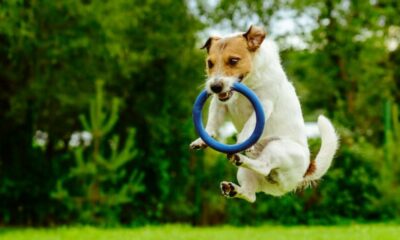SEO
11 Classic Examples Of Exceptional Jingle & Slogan Writing

The best copywriting makes an emotional connection that leaves your audience craving more.
How can you make this sort of memorable impression on your target audience?
The slogans and jingles used by major brands are designed to stick in the audience’s mind.
That way, months or even years later, you may catch yourself humming a tune from a commercial or reciting a catchy slogan.
In this article, you’ll find 11 examples of the most popular slogans and jingles in advertising and learn the copywriting tricks that make them so compelling.
11. Motel 6: “We’ll Leave The Light On For You.”
This Motel 6 slogan was born in the best way: as an ad-libbed line-turned-instant success – and a perfect representation of the motel brand and its values.
Created off the cuff by NPR personality Tom Bodett, this slogan was an optimal way to convey the hotel chain’s welcoming spirit, affordable prices, and general availability.
A slogan that has lasted more than 30 years with no signs of stopping, it clearly stands for what Motel 6 is trying to communicate.
And it’s working.
If it isn’t broke, don’t fix it.
10. Maybelline: “Maybe She’s Born With It. Maybe It’s Maybelline.”
Used since 1991, the slogan was the anchor for “the number one cosmetics company in America” and its advertising.
It made it until 2016, when it was replaced by the brand’s new “Make it Happen” tagline. But not before it was voted “most recognizable” over the last 150 years by Marketing Week in 2013.
9. Red Bull: “Red Bull Gives You Wings.”
Red Bull has been a revolutionary product creating a revolutionary experience since the Austrian company’s inception in 1987.
And what better way to do that than with a slogan like “Red Bull gives you wings” for an energy drink that was going to change your day, and ultimately your life?
The only problem was, Red Bull wasn’t offering much more than the average cup of coffee in terms of a jolt (via caffeine). And the U.S. District Court of the Southern District of New York decided that the slogan was misleading customers.
The extra pep in your step – or “wings” as Red Bull called them in its marketing – was deemed ambiguous and Red Bull paid out a $13 million settlement.
8. Skittles: “Taste The Rainbow.”
Remarkably, even decades after it was created, the slogan for Skittles, “Taste the rainbow” has done plenty right.
What began in 1963 under the name “Glees,” Skittles have become the most popular non-chocolate candy in America with its iconic slogan.
Sure, being a tasty candy helps.
But the brand’s marketing has found a way to keep the same slogan throughout multiple generations, all while effectively communicating with its audience in a way that has kept us listening, watching, and even laughing.
The slogan has helped convey an enticing image for its product and its relationship with the “rainbow” reference, a connection it will likely always – at least for the general future – be associated with.
And for good reason.
7. McDonald’s: “I’m Lovin’ It.”
Another jingle that was communicated – at least in the beginning – by a famous personality was McDonald’s long-running slogan of “I’m lovin’ it,” which got assistance from Justin Timberlake in 2003 when it launched.
The fast-food company’s campaign was anchored around the J.T. song by the same name, which became one of Timberlake’s full-length songs on his album at the time.
McDonald’s spent $1.37 billion in advertising in 2003 when the campaign launched, which led to an 11% increase in sales that year ($17.1 billion).
So, yeah, you could say it worked.
6. Marines: “The Few. The Proud. The Marines.”
Used since 1977, “The Few. The Proud. The Marines.” has remained one of the Marines’ primary recruiting slogans, but it hasn’t been the only one.
Other, similar slogans were used (i.e., “If everybody could get in the Marines, it wouldn’t be the Marines”) but none have lasted as long as “The Few. The Proud.”
Each supplemental slogan has served a distinct purpose to the Marines recruiting missions in terms of needs of the military branch throughout different generations, according to the Marine Times.
“The Few. The Proud.” was nearly dropped in 2016 after the organization explored other possibilities but made a proud return to the Marines’ marketing strategy after a short hiatus in 2017.
“‘The Few. The Proud.” does a great job distinguishing (the Marines) from the other branches (of military) and making us prestigious to recruits, but it doesn’t say anything about what we do or why we exist,” said Lt. Col. John Caldwell, a spokesman for Marine Corps Recruiting Command, to the Marine Corps Times in 2016.
5. Army: “Be All You Can Be.”
While the Army has since stopped using its “Be all you can be” slogan, its impact cannot and has not been ignored.
And it still resonates today.
The slogan was used by the land warfare service branch from 1980 through 2001 and was eventually replaced by several new attempts to effectively reach its target audience.
First came “An Army of one,” which ran from 2001 to 2006 but didn’t show the same success as “Be all you can be.”
That was eventually replaced by the short salute “Army strong” in 2006, which was successful, but did not carry the same type of message as “Be all you can be,” according to Sergeant Major of the Army Daniel Dailey.
“‘Be All You Can Be’ was a national identity to the Army … it is still today,” Dailey said. “I can say ‘Be All You Can Be’ and people just – it was the national identity to the Army.”
That’s a slogan that’s certainly implanted in many of us who grew up around that 21-year stretch of “Be all you can be” messaging. I know I’m one of them.
4. Burger King: “Have It Your Way.”
The fast-food chain’s most successful slogan to date, “Have it your way” was a revolutionary call-to-action for Burger King’s customers to order what they want, how they want it.
It’s easily Burger King’s most well-known slogan in a battle that was devoted to catching up to McDonald’s while also fending off other chain challengers. The slogan helped (the best it could).
BK ditched the phrase in 2014 and has since replaced it with several new slogans, including the “Be your way” slogan and, most recently, “Feel your way” slogan, both obvious plays on the original jingle.
3. GEICO: “15 Minutes Could Save You 15% or More on Car Insurance.”
GEICO spends more than a billion dollars a year to tell potential customers they could save money if they use it as their insurance company.
It was the top brand advertiser on YouTube in 2019, and it shows.
We all know the slogan – and the humorous commercials that often accompany it.
It’s simple, concise, and communicated across a multitude of mediums: switch to GEICO and you’ll save money.
It’s also (mostly) true, according to a study by Forbes.
Catchy, easy-to-remember, and, most of all, legitimate in its claim – the GEICO recipe for success has helped build one of the most noticeable brands in America.
It also helps to have deep pockets, A.K.A. budget.
2. Farmer’s Insurance: “We Know A Thing Or Two Because We’ve Seen A Thing Or Two.”
Another insurance company making big noise in a clouded insurance market is Farmer’s.
Competing among some of the most notable advertisements in rotation (see: Geico, State Farm, All State), Farmer’s nails this slogan that is based on real-life facts and statistics and also relays a message of confidence and trust to its customers.
Built around the idea that Farmer’s has dealt with some seemingly unbelievable insurance claims – and properly taken care of those involved and covered by Farmer’s – the car insurance company-turned multi-line, multi-company insurer and financial services group even has Unbelievable Claims section on its website to back up its claim.
It’s tough to contend with high spenders like GEICO, but at least when Farmer’s does it, it drives home a strong and meaningful (and true!) slogan that can help put customers at ease.
1. Nike: “Just Do It.”
The power of the best slogan of the several decades comes from not just its longevity, but its overall impact, not just on the fitness and footwear industries, but in powerful and meaningful walks of life.
That it would also help shift the industry when Nike needed it most makes it that much better, too.
Aiming to gain market share from other brands like Reebok, advertising executive Dan Wieden created the game-changing slogan on Nike’s behalf from two unusual places in 1988, further adding to the longstanding tagline’s lore.
“It was about the ultimate statement of intention,” Liz Dolan, former chief marketing officer at Nike, told The Washington Post. “It had to be personal.”
And it was and continues to be.
Just as momentous as its support to helping Nike grow into the worldwide powerhouse it is today is the ability it has had to adapt and continue to still inspire to this day.
From Colin Kaepernick and his stance against social injustices to women’s equality and admiration, to being a large part of some of the gutsiest performances by athletes across the world, Nike’s message has consistently motivated humans to be faster, stronger, and better.
“Just do it” has only grown in intensity and effectiveness as Nike continues to utilize the message and the underlying drive-home point in all of its overarching messaging.
It’s evolved into a cultural rally cry for standing up for what’s right, fighting your hardest, and making a real impact that isn’t limited to the field, court, or rink.
Nike will continue to use the infamous tagline for many more years to come, and it will likely keep winning by doing so and shifting with the times.
Slogan Writing Tips and Resources
Ready to write a catchy slogan for your brand?
Here are some resources that will help you sharpen your writing skills.
Incorporate your brand’s main keyword phrase like Geico or name like Maybelline to ensure your audience remembers the most important part of your message.
Conclusion
If you instantly recognized or had music come to mind when seeing one of these examples, congratulations.
It just proves that slogans and jingles have the kind of staying power you want in your advertising and marketing.
More resources:
Featured Image: Shutterstock/Yuliia D
SEO
Measuring Content Impact Across The Customer Journey

Understanding the impact of your content at every touchpoint of the customer journey is essential – but that’s easier said than done. From attracting potential leads to nurturing them into loyal customers, there are many touchpoints to look into.
So how do you identify and take advantage of these opportunities for growth?
Watch this on-demand webinar and learn a comprehensive approach for measuring the value of your content initiatives, so you can optimize resource allocation for maximum impact.
You’ll learn:
- Fresh methods for measuring your content’s impact.
- Fascinating insights using first-touch attribution, and how it differs from the usual last-touch perspective.
- Ways to persuade decision-makers to invest in more content by showcasing its value convincingly.
With Bill Franklin and Oliver Tani of DAC Group, we unravel the nuances of attribution modeling, emphasizing the significance of layering first-touch and last-touch attribution within your measurement strategy.
Check out these insights to help you craft compelling content tailored to each stage, using an approach rooted in first-hand experience to ensure your content resonates.
Whether you’re a seasoned marketer or new to content measurement, this webinar promises valuable insights and actionable tactics to elevate your SEO game and optimize your content initiatives for success.
View the slides below or check out the full webinar for all the details.
SEO
How to Find and Use Competitor Keywords

Competitor keywords are the keywords your rivals rank for in Google’s search results. They may rank organically or pay for Google Ads to rank in the paid results.
Knowing your competitors’ keywords is the easiest form of keyword research. If your competitors rank for or target particular keywords, it might be worth it for you to target them, too.
There is no way to see your competitors’ keywords without a tool like Ahrefs, which has a database of keywords and the sites that rank for them. As far as we know, Ahrefs has the biggest database of these keywords.
How to find all the keywords your competitor ranks for
- Go to Ahrefs’ Site Explorer
- Enter your competitor’s domain
- Go to the Organic keywords report
The report is sorted by traffic to show you the keywords sending your competitor the most visits. For example, Mailchimp gets most of its organic traffic from the keyword “mailchimp.”


Since you’re unlikely to rank for your competitor’s brand, you might want to exclude branded keywords from the report. You can do this by adding a Keyword > Doesn’t contain filter. In this example, we’ll filter out keywords containing “mailchimp” or any potential misspellings:


If you’re a new brand competing with one that’s established, you might also want to look for popular low-difficulty keywords. You can do this by setting the Volume filter to a minimum of 500 and the KD filter to a maximum of 10.


How to find keywords your competitor ranks for, but you don’t
- Go to Competitive Analysis
- Enter your domain in the This target doesn’t rank for section
- Enter your competitor’s domain in the But these competitors do section


Hit “Show keyword opportunities,” and you’ll see all the keywords your competitor ranks for, but you don’t.


You can also add a Volume and KD filter to find popular, low-difficulty keywords in this report.


How to find keywords multiple competitors rank for, but you don’t
- Go to Competitive Analysis
- Enter your domain in the This target doesn’t rank for section
- Enter the domains of multiple competitors in the But these competitors do section


You’ll see all the keywords that at least one of these competitors ranks for, but you don’t.


You can also narrow the list down to keywords that all competitors rank for. Click on the Competitors’ positions filter and choose All 3 competitors:


- Go to Ahrefs’ Site Explorer
- Enter your competitor’s domain
- Go to the Paid keywords report


This report shows you the keywords your competitors are targeting via Google Ads.
Since your competitor is paying for traffic from these keywords, it may indicate that they’re profitable for them—and could be for you, too.
You know what keywords your competitors are ranking for or bidding on. But what do you do with them? There are basically three options.
1. Create pages to target these keywords
You can only rank for keywords if you have content about them. So, the most straightforward thing you can do for competitors’ keywords you want to rank for is to create pages to target them.
However, before you do this, it’s worth clustering your competitor’s keywords by Parent Topic. This will group keywords that mean the same or similar things so you can target them all with one page.
Here’s how to do that:
- Export your competitor’s keywords, either from the Organic Keywords or Content Gap report
- Paste them into Keywords Explorer
- Click the “Clusters by Parent Topic” tab


For example, MailChimp ranks for keywords like “what is digital marketing” and “digital marketing definition.” These and many others get clustered under the Parent Topic of “digital marketing” because people searching for them are all looking for the same thing: a definition of digital marketing. You only need to create one page to potentially rank for all these keywords.


2. Optimize existing content by filling subtopics
You don’t always need to create new content to rank for competitors’ keywords. Sometimes, you can optimize the content you already have to rank for them.
How do you know which keywords you can do this for? Try this:
- Export your competitor’s keywords
- Paste them into Keywords Explorer
- Click the “Clusters by Parent Topic” tab
- Look for Parent Topics you already have content about
For example, if we analyze our competitor, we can see that seven keywords they rank for fall under the Parent Topic of “press release template.”


If we search our site, we see that we already have a page about this topic.


If we click the caret and check the keywords in the cluster, we see keywords like “press release example” and “press release format.”


To rank for the keywords in the cluster, we can probably optimize the page we already have by adding sections about the subtopics of “press release examples” and “press release format.”
3. Target these keywords with Google Ads
Paid keywords are the simplest—look through the report and see if there are any relevant keywords you might want to target, too.
For example, Mailchimp is bidding for the keyword “how to create a newsletter.”


If you’re ConvertKit, you may also want to target this keyword since it’s relevant.
If you decide to target the same keyword via Google Ads, you can hover over the magnifying glass to see the ads your competitor is using.


You can also see the landing page your competitor directs ad traffic to under the URL column.


Learn more
Check out more tutorials on how to do competitor keyword analysis:
SEO
Google Confirms Links Are Not That Important

Google’s Gary Illyes confirmed at a recent search marketing conference that Google needs very few links, adding to the growing body of evidence that publishers need to focus on other factors. Gary tweeted confirmation that he indeed say those words.
Background Of Links For Ranking
Links were discovered in the late 1990’s to be a good signal for search engines to use for validating how authoritative a website is and then Google discovered soon after that anchor text could be used to provide semantic signals about what a webpage was about.
One of the most important research papers was Authoritative Sources in a Hyperlinked Environment by Jon M. Kleinberg, published around 1998 (link to research paper at the end of the article). The main discovery of this research paper is that there is too many web pages and there was no objective way to filter search results for quality in order to rank web pages for a subjective idea of relevance.
The author of the research paper discovered that links could be used as an objective filter for authoritativeness.
Kleinberg wrote:
“To provide effective search methods under these conditions, one needs a way to filter, from among a huge collection of relevant pages, a small set of the most “authoritative” or ‘definitive’ ones.”
This is the most influential research paper on links because it kick-started more research on ways to use links beyond as an authority metric but as a subjective metric for relevance.
Objective is something factual. Subjective is something that’s closer to an opinion. The founders of Google discovered how to use the subjective opinions of the Internet as a relevance metric for what to rank in the search results.
What Larry Page and Sergey Brin discovered and shared in their research paper (The Anatomy of a Large-Scale Hypertextual Web Search Engine – link at end of this article) was that it was possible to harness the power of anchor text to determine the subjective opinion of relevance from actual humans. It was essentially crowdsourcing the opinions of millions of website expressed through the link structure between each webpage.
What Did Gary Illyes Say About Links In 2024?
At a recent search conference in Bulgaria, Google’s Gary Illyes made a comment about how Google doesn’t really need that many links and how Google has made links less important.
Patrick Stox tweeted about what he heard at the search conference:
” ‘We need very few links to rank pages… Over the years we’ve made links less important.’ @methode #serpconf2024″
Google’s Gary Illyes tweeted a confirmation of that statement:
“I shouldn’t have said that… I definitely shouldn’t have said that”
Why Links Matter Less
The initial state of anchor text when Google first used links for ranking purposes was absolutely non-spammy, which is why it was so useful. Hyperlinks were primarily used as a way to send traffic from one website to another website.
But by 2004 or 2005 Google was using statistical analysis to detect manipulated links, then around 2004 “powered-by” links in website footers stopped passing anchor text value, and by 2006 links close to the words “advertising” stopped passing link value, links from directories stopped passing ranking value and by 2012 Google deployed a massive link algorithm called Penguin that destroyed the rankings of likely millions of websites, many of which were using guest posting.
The link signal eventually became so bad that Google decided in 2019 to selectively use nofollow links for ranking purposes. Google’s Gary Illyes confirmed that the change to nofollow was made because of the link signal.
Google Explicitly Confirms That Links Matter Less
In 2023 Google’s Gary Illyes shared at a PubCon Austin that links were not even in the top 3 of ranking factors. Then in March 2024, coinciding with the March 2024 Core Algorithm Update, Google updated their spam policies documentation to downplay the importance of links for ranking purposes.
The documentation previously said:
“Google uses links as an important factor in determining the relevancy of web pages.”
The update to the documentation that mentioned links was updated to remove the word important.
Links are not just listed as just another factor:
“Google uses links as a factor in determining the relevancy of web pages.”
At the beginning of April Google’s John Mueller advised that there are more useful SEO activities to engage on than links.
Mueller explained:
“There are more important things for websites nowadays, and over-focusing on links will often result in you wasting your time doing things that don’t make your website better overall”
Finally, Gary Illyes explicitly said that Google needs very few links to rank webpages and confirmed it.
I shouldn’t have said that… I definitely shouldn’t have said that
— Gary 鯨理/경리 Illyes (so official, trust me) (@methode) April 19, 2024
Why Google Doesn’t Need Links
The reason why Google doesn’t need many links is likely because of the extent of AI and natural language undertanding that Google uses in their algorithms. Google must be highly confident in its algorithm to be able to explicitly say that they don’t need it.
Way back when Google implemented the nofollow into the algorithm there were many link builders who sold comment spam links who continued to lie that comment spam still worked. As someone who started link building at the very beginning of modern SEO (I was the moderator of the link building forum at the #1 SEO forum of that time), I can say with confidence that links have stopped playing much of a role in rankings beginning several years ago, which is why I stopped about five or six years ago.
Read the research papers
Authoritative Sources in a Hyperlinked Environment – Jon M. Kleinberg (PDF)
The Anatomy of a Large-Scale Hypertextual Web Search Engine
Featured Image by Shutterstock/RYO Alexandre
-

 PPC4 days ago
PPC4 days ago19 Best SEO Tools in 2024 (For Every Use Case)
-

 MARKETING7 days ago
MARKETING7 days agoWill Google Buy HubSpot? | Content Marketing Institute
-
SEARCHENGINES7 days ago
Daily Search Forum Recap: April 16, 2024
-

 SEO7 days ago
SEO7 days agoGoogle Clarifies Vacation Rental Structured Data
-

 MARKETING6 days ago
MARKETING6 days agoStreamlining Processes for Increased Efficiency and Results
-
SEARCHENGINES6 days ago
Daily Search Forum Recap: April 17, 2024
-

 SEO6 days ago
SEO6 days agoAn In-Depth Guide And Best Practices For Mobile SEO
-

 PPC6 days ago
PPC6 days ago97 Marvelous May Content Ideas for Blog Posts, Videos, & More








![What’s Media Mix Modeling? [Marketer’s Guide with Examples] What’s Media Mix Modeling? [Marketer’s Guide with Examples]](https://articles.entireweb.com/wp-content/uploads/2024/03/Whats-Media-Mix-Modeling-Marketers-Guide-with-Examples-400x240.jpg)
![What’s Media Mix Modeling? [Marketer’s Guide with Examples] What’s Media Mix Modeling? [Marketer’s Guide with Examples]](https://articles.entireweb.com/wp-content/uploads/2024/03/Whats-Media-Mix-Modeling-Marketers-Guide-with-Examples-80x80.jpg)





You must be logged in to post a comment Login